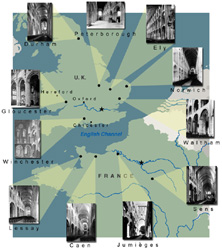| |
Durham
Cathedral and Anglo-Norman Romanesque
Professor Roger Stalley

|
 |
|
 |
Although
the
contents of this section on Durham
Cathedral are laid out in a logical sequence, moving from
the history and description of the building to a broader
discussion of its importance, there is no reason why individual
sections cannot be approached in any order. The aim is
to explore one of the outstanding buildings of the middle
ages, while at the same time using the monument as a framework
to consider some of the key issues associated with Romanesque.
As well as tackling architectural matters, such as the
function of the rib or the significance of alternation,
this briefing also touches on broader questions such as
the nature of regional schools and the concept of pilgrimage
churches; it also provides an insight into methods of
analysing monuments and ways of evaluating primary sources.
The term Romanesque is generally applied to buildings
constructed in the eleventh and twelfth centuries. Although
invented less than two hundred years ago, the term is
appropriate, since it suggests the degree to which builders
of this period revived and adapted techniques inherited
from the architecture
of the Roman world.
Before examining Durham Cathedral in detail, there are
a number of general characteristics associated with Romanesque
building that need to be considered, These include the
following:
|
| 1.
|
The
increasing 'articulation' of buildings from c. 1030 onwards,
through the use of engaged
shafts, multiple (recessed) orders,
and compound
piers. These developments are thought to have originated
in central France, in the area of the Loire valley, before
spreading north to Normandy. The choir of the abbey church
at Lessay, finished by 1098, or the nave of St Etienne
at Caen, provide clear illustrations of the way in which
the techniques were applied to a three storeyed church
with aisles. |
 |
| |


France,
Lessay, Abbey Church of Saint Trinité, General
view from southwest

|
|


France,
Lessay, Abbey Church of Saint Trinité, Choir

|


France,
Caen, St. Etienne, View of west façade

|
|


France,
Caen, St. Etienne, Nave looking east

|


France, Caen, St. Etienne, General view from east
end from southwest

|
 |


France,
Caen, St. Etienne, North elevation of nave from
southeast

|
|
 |
| 2. |
The
increase in scale and complexity of architecture. This
had a direct affect on the processes of design and the
status of the master mason. Furthermore, the sheer quantity
of building, along with the need for high quality masonry,
led to a more professional approach both to construction
and to quarrying stone. The ambitious scale of many Romanesque
churches also had consequences for the length of time
they took to complete. |
 |
| |
[IMAGES
FORTHCOMING] HERE WE'LL INSERT A SERIES OF PLANS TO SHOW
COMPLEXITY AND SCALE OF ENGLISH ROMANESQUE INCLUDING Canterbury,
Durham, Ely, Gloucester, Norwich |
 |
| 3. |
The
development of architectural sculpture: the intimate relationship
between architecture and sculpture became one of the hallmarks
of the Romanesque style. Carved ornament was frequently
used to accentuate the main lines and basic forms of the
buildings. |
 |
| |


England,
Durham Cathedral, Detail of wall arcading

|
 |
| 4.
|
The
development of stone vaulting.
The Romanesque era was a time of experiment, involving
various solutions to the problem of how to cover the main
spaces of large churches with ceilings of stone. The developments
have been considered from several different points of
view, some historians stressing the aesthetic merits of
what happened, others pointing to 'iconographical' or
symbolical motives, while more traditional scholars have
considered the developments in purely structural terms.
|
 |
 |


England,
Durham Cathedral

|
 |
| 5.
|
Although
the term Romanesque has been applied to buildings throughout
Europe, it does not represent a consistent or uniform
style. The relationship between local practice and that
employed more universally across Europe is one of the
fundamental issues that confronts historians of the period.
In effect the historian is presented with a tension or
'dialogue' between regionalism and universality. |
 |
 |
[IMAGES
FORTHCOMING] Here we'll insert comparative examples from
France, Germany and Italy, one interior and one exterior
view of three buildings |
 |
| 6.
|
The
reasons for change. Explanations for the development of
the Romanesque style and for the creation of churches
of unprecedented scale cannot be sought exclusively within
the field of architecture itself. The historian of architecture
has to adopt a 'contextual' approach, examining the extent
to which architecture reflects more fundamental changes
in society, whether they be economic, political, or religious.
|
 |
| 7. |
Romanesque
architecture in England: as in many areas of Europe, the
Romanesque architecture of England does not present a
simple or uniform picture. The differences between buildings
are often more striking than their similarities. In at
least three crucial respects English practice varied quite
markedly: |
 |
 |
| • |
The
planning of the eastern limb of the church: this
could be laid out with a semi-circular ambulatory
or with apses en échelon or with some form
of 'square' or flat east end, with or without an
ambulatory. |
 |
|
| • |
The
interior elevation: here there was a choice between
cylindrical piers and compound piers or a compromise
between the two. The choice of pier design had repercussions
on the general articulation of the building and
on the degree to which the various storeys were
integrated together. |
 |
|
| • |
The
ceiling: here the choice lay between a heavy stone
vault (as at Durham) or some form of timber ceiling
(as in the choir of Canterbury 1096–1130);
most English Romanesque churches opted for the latter
solution. |
 |
|
|
briefing
| image index | resources
home page | site
image index | site resources
media center for art history, archaeology and historic preservation
| columbia university
|
|

